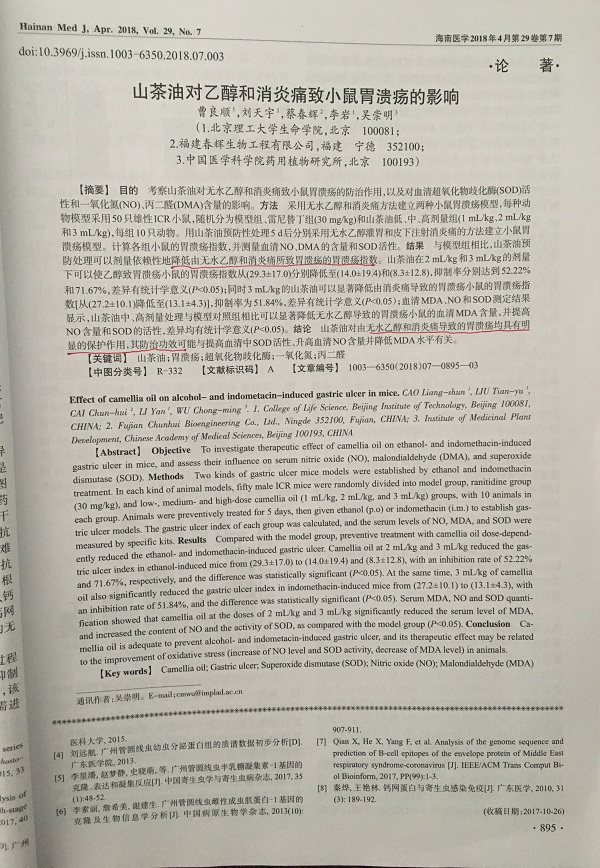春辉生物;北京理工大学;医学科学院研究《山茶油对乙醇和消炎痛致小鼠胃溃疡的影响》在海南医学发表
页面更新时间:2018-09-05 02:38
春辉生物;京理工大学生命学院;中国医学科学院药用植物研究所; 研究《山茶油对乙醇和消炎痛致小鼠胃溃疡的影响》在海南医学发表
《海南医学》 2018年07期 收藏 | 投稿 | 手机打开
山茶油对乙醇和消炎痛致小鼠胃溃疡的影响
曹良顺 刘天宇 蔡春辉 李岩 吴崇明
【摘要】:目的考察山茶油对无水乙醇和消炎痛致小鼠胃溃疡的防治作用,以及对血清超氧化物歧化酶(SOD)活性和一氧化氮(NO)、丙二醛(DMA)含量的影响。方法采用无水乙醇和消炎痛方法建立两种小鼠胃溃疡模型,每种动物模型采用50只雄性ICR小鼠,随机分为模型组、雷尼替丁组(30 mg/kg)和山茶油低、中、高剂量组(1 mL/kg、2 mL/kg和3 mL/kg),每组10只动物。用山茶油预防性处理5 d后分别采用无水乙醇灌胃和皮下注射消炎痛的方法建立小鼠胃溃疡模型。计算各组小鼠的胃溃疡指数,并测量血清NO、DMA的含量和SOD活性。结果与模型组相比,山茶油预防处理可以剂量依赖性地降低由无水乙醇和消炎痛所致胃溃疡的胃溃疡指数。山茶油在2 mL/kg和3 mL/kg的剂量下可以使乙醇致胃溃疡小鼠的胃溃疡指数从(29.3±17.0)分别降低至(14.0±19.4)和(8.3±12.8),抑制率分别达到52.22%和71.67%,差异有统计学意义(P0.05);同时3 mL/kg的山茶油可以显著降低由消炎痛导致的胃溃疡小鼠的胃溃疡指数[从(27.2±10.1)降低至(13.1±4.3)],抑制率为51.84%,差异有统计学意义(P0.05);血清MDA、NO和SOD测定结果显示,山茶油中、高剂量处理与模型对照组相比可以显著降低无水乙醇导致的胃溃疡小鼠的血清MDA含量,并提高NO含量和SOD的活性,差异均有统计学意义(P0.05)。结论山茶油对由无水乙醇和消炎痛导致的胃溃疡均具有明显的保护作用,其防治功效可能与提高血清中SOD活性、升高血清NO含量并降低MDA水平有关。
【作者单位】: 北京理工大学生命学院;福建春辉生物工程有限公司;中国医学科学院药用植物研究所;
【分类号】:R285.5
春辉生物;北京理工大学;医学科学院研究《山茶油对乙醇和消炎痛致小鼠胃溃疡的影响》在海南医学发表
标题:山茶油对乙醇和消炎痛致小鼠胃溃疡的影响 作者:曹良顺 1,刘天宇 1,蔡春辉 2,李岩 1,吴崇明 3 卷次:2018年29卷7期
(1.北京理工大学生命学院,北京 100081;2.福建春辉生物工程有限公司,福建 宁德 352100;3.中国医学科学院药用植物研究所,北京 100193)【摘要】 目的 考察山茶油对无水乙醇和消炎痛致小鼠胃溃疡的防治作用,以及对血清超氧化物歧化酶(SOD)活性和一氧化氮(NO)、丙二醛(DMA)含量的影响。方法 采用无水乙醇和消炎痛方法建立两种小鼠胃溃疡模型,每种动物模型采用50只雄性 ICR小鼠,随机分为模型组、雷尼替丁组(30 mg/kg)和山茶油低、中、高剂量组(1 mL/kg、2 mL/kg和3 mL/kg),每组10只动物。用山茶油预防性处理5 d后分别采用无水乙醇灌胃和皮下注射消炎痛的方法建立小鼠胃溃疡模型。计算各组小鼠的胃溃疡指数,并测量血清NO、DMA的含量和SOD活性。结果 与模型组相比,山茶油预防处理可以剂量依赖性地降低由无水乙醇和消炎痛所致胃溃疡的胃溃疡指数。山茶油在2 mL/kg和3 mL/kg的剂量下可以使乙醇致胃溃疡小鼠的胃溃疡指数从(29.3±17.0)分别降低至(14.0±19.4)和(8.3±12.8),抑制率分别达到52.22%和71.67%,差异有统计学意义(P<0.05);同时3 mL/kg的山茶油可以显著降低由消炎痛导致的胃溃疡小鼠的胃溃疡指数[从(27.2±10.1)降低至(13.1±4.3)],抑制率为51.84%,差异有统计学意义(P<0.05);血清MDA、NO和SOD测定结果显示,山茶油中、高剂量处理与模型对照组相比可以显著降低无水乙醇导致的胃溃疡小鼠的血清MDA含量,并提高NO含量和SOD的活性,差异均有统计学意义(P<0.05)。结论 山茶油对由无水乙醇和消炎痛导致的胃溃疡均具有明显的保护作用,其防治功效可能与提高血清中SOD活性、升高血清NO含量并降低MDA水平有关。【关键词】 山茶油;胃溃疡;超氧化物歧化酶;一氧化氮;丙二醛【中图分类号】 R-332 【文献标识码】 A 【文章编号】 1003—6350(2018)07—0895—03Effect of camellia oil on alcohol- and indometacin-induced gastric ulcer in mice. CAO Liang-shun 1, LIU Tian-yu 1,CAI Chun-hui 2, LI Yan 1, WU Chong-ming 3. 1. College of Life Science, Beijing Institute of Technology, Beijing 100081,CHINA; 2. Fujian Chunhui Bioengineering Co., Ltd., Ningde 352100, Fujian, CHINA; 3. Institute of Medicinal PlantDevelopment, Chinese Academy of Medical Sciences, Beijing 100193, CHINA【Abstract】 Objective To investigate therapeutic effect of camellia oil on ethanol- and indomethacin-inducedgastric ulcer in mice, and assess their influence on serum nitric oxide (NO), malondialdehyde (DMA), and superoxidedismutase (SOD). Methods Two kinds of gastric ulcer mice models were established by ethanol and indomethacintreatment. In each kind of animal models, fifty male ICR mice were randomly divided into model group, ranitidine group(30 mg/kg), and low-, medium- and high-dose camellia oil (1 mL/kg, 2 mL/kg, and 3 mL/kg) groups, with 10 animals ineach group. Animals were preventively treated for 5 days, then given ethanol (p.o) or indomethacin (i.m.) to establish gas-tric ulcer models. The gastric ulcer index of each group was calculated, and the serum levels of NO, MDA, and SOD weremeasured by specific kits. Results Compared with the model group, preventive treatment with camellia oil dose-depend-ently reduced the ethanol- and indomethacin-induced gastric ulcer. Camellia oil at 2 mL/kg and 3 mL/kg reduced the gas-tric ulcer index in ethanol-induced mice from (29.3±17.0) to (14.0±19.4) and (8.3±12.8), with an inhibition rate of 52.22%and 71.67%, respectively, and the difference was statistically significant (P<0.05). At the same time, 3 mL/kg of camelliaoil also significantly reduced the gastric ulcer index in indomethacin-induced mice from (27.2±10.1) to (13.1±4.3), withan inhibition rate of 51.84%, and the difference was statistically significant (P<0.05). Serum MDA, NO and SOD quanti-fication showed that camellia oil at the doses of 2 mL/kg and 3 mL/kg significantly reduced the serum level of MDA,and increased the content of NO and the activity of SOD, as compared with the model group (P<0.05). Conclusion Ca-mellia oil is adequate to prevent alcohol- and indometacin-induced gastric ulcer, and its therapeutic effect may be relatedto the improvement of oxidative stress (increase of NO level and SOD activity, decrease of MDA level) in animals.【Key words】 Camellia oil; Gastric ulcer; Superoxide dismutase (SOD); Nitric oxide (NO); Malondialdehyde (MDA)doi:10.3969/j.issn.1003-6350.2018.07.003

